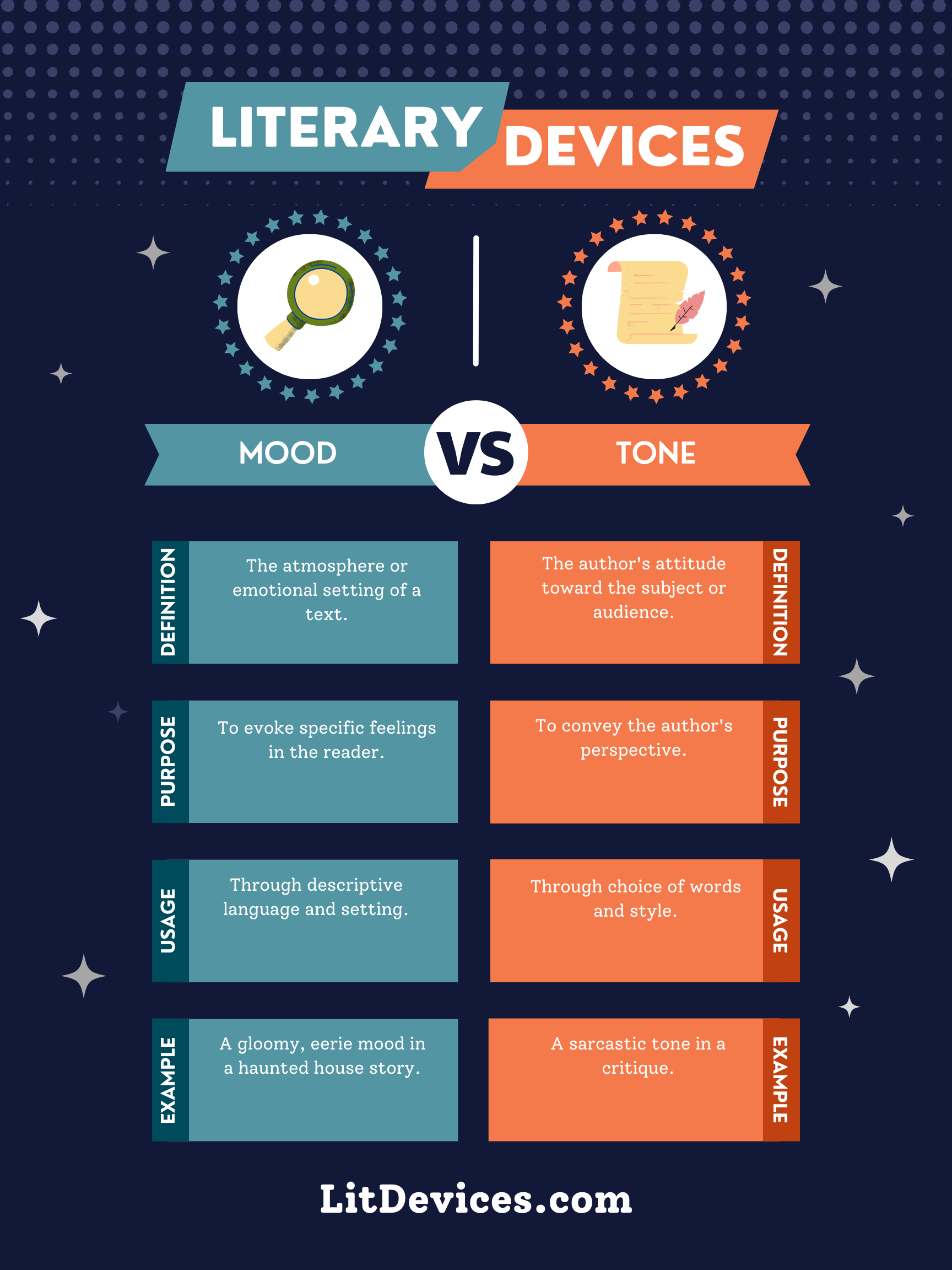Mood is the atmosphere or emotional setting created by a work; Tone is the author’s attitude toward the subject.
Mood
Mood refers to the general atmosphere or emotional setting of a story, designed to evoke specific feelings or vibes in the audience. It is created through setting, theme, and diction.
🌧 Example: In Edgar Allan Poe’s “The Fall of the House of Usher,” the description of the decaying mansion under a gray sky establishes a mood of gloom and dread.
Tone
Tone reflects the author’s attitude towards the subject or the audience. It is conveyed through the writer’s choice of words and details.
📝 Example: In Jane Austen’s “Pride and Prejudice,” the tone is often ironic and playful, especially in descriptions of social mores and marriage.
Summary
| Literary Device | Definition | Purpose | Usage | Relevant Examples |
|---|---|---|---|---|
| Mood | The emotional atmosphere that a writer creates for the reader. | To evoke specific feelings in the reader through the setting, theme, and diction. | Used across genres to engage readers emotionally and enhance the narrative. | The eerie mood of “The Raven” by Edgar Allan Poe. |
| Tone | The author’s attitude towards the subject or the audience. | To convey the author’s perspective and influence the reader’s perception of the subject. | Manifested in word choice, viewpoint, and style throughout the text. | The satirical tone of “A Modest Proposal” by Jonathan Swift. |
Writing Tips
When working with mood and tone:
- For Mood: Focus on sensory details to build the world your characters inhabit. Think about how you want your reader to feel in each scene and use setting, imagery, and diction to achieve that effect.
- For Tone: Be mindful of your word choice and sentence structure. The tone can shift throughout your work to match the development of your narrative or characters, but it should always be intentional to effectively convey your attitude towards the subject.
🖋 Example for Mood: To create a suspenseful mood, use descriptive language that emphasizes the unknown or the lurking danger, such as a stormy night or a mysterious noise.
🖋 Example for Tone: If your tone is humorous, employ witty remarks, puns, or a light-hearted narrative style, even when dealing with serious subjects, to keep the reader engaged and amused.
FAQs
How do mood and tone differ in purpose?
Mood aims to evoke an emotional response from the reader, whereas tone reflects the author’s attitude towards the subject or the audience.
Can the tone of a work affect its mood?
Yes, the tone set by the author can significantly influence the work’s mood by shaping how the subject matter is presented and perceived.
Is it possible for mood and tone to contradict each other?
While they often complement each other, mood and tone can sometimes contradict, creating a complex and nuanced reading experience. This contrast can be used deliberately to add depth to the narrative.
Exercise
Identify whether the following descriptions are more indicative of mood or tone:
- The narrator describes the abandoned house with words like “creeping,” “shattered,” and “haunting.”
- The author’s use of sarcastic comments when discussing a character’s decision-making.
- A description of a peaceful garden that uses words like “tranquil,” “lush,” and “blossoming” to set the scene.
- A critical viewpoint on societal norms, expressed through biting satire.
Answers:
Interesting Literary Device Comparisons
- Symbolism vs. Imagery: Symbolism uses objects, figures, or colors as symbols to represent larger concepts or ideas, while imagery relies on descriptive language to create visual pictures in the reader’s mind, enhancing the sensory experience of the narrative.
- Characterization vs. Dialogue: Characterization is the process of creating and developing characters in a story, often through their actions, speech, thoughts, and interactions with others. Dialogue specifically refers to the spoken words between characters, serving as a direct tool for characterization and advancing the plot.
- Flashback vs. Foreshadowing: Flashbacks are interruptions in the narrative to recount events that happened in the past, providing background or context to the current events. Foreshadowing hints at future

